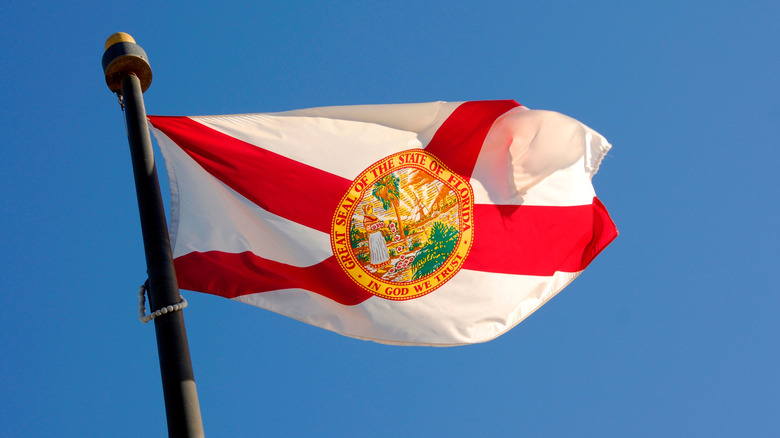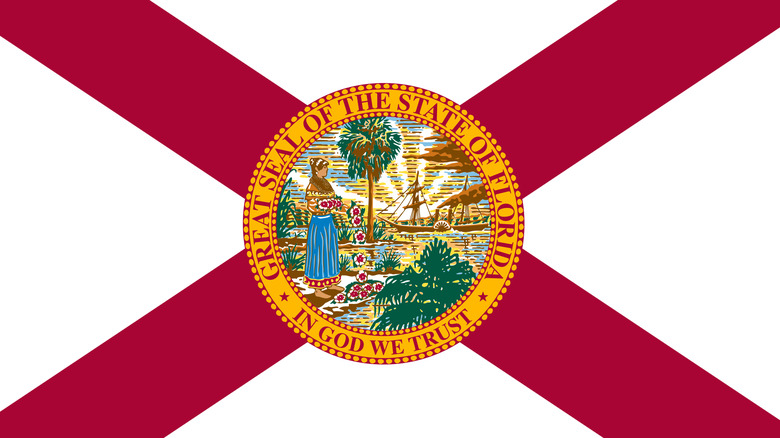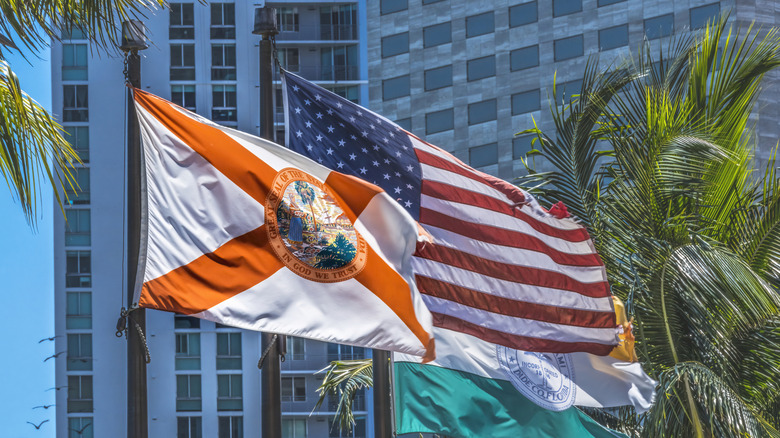What Does The Florida State Flag Symbolize?
With all of the red, white, and blue stars and stripes waving in the air, it's easy to forget that each U.S. state has its own flag. Some are plain, like Alabama's red X against a white background. Others, like New Mexico's flag, not only have a really unique design, but a poignant meaning related to the four seasons of life. All in all, you'll notice that state flags are generally way more interesting and intricate than country flags, filled with lots of little symbols and pictures. That's where the Florida state flag comes into play. Looking like the Alabama flag with a circular image stamped on top of it, the Florida flag has a lot of complexity for a state that's become the butt of a lot of jokes about being ridiculous and dumb.
Considering that Florida became a state only in 1845 (the 27th state), its flag has gone through a lot of iterations. After being bought from Spain in 1819, it took a full 16 years from 1845 to 1861 for Florida to draft its original flag. That flag had three broad stripes on the right — red, white, red — and a circular insignia against a blue background on the left. That design came from an earlier, Texas-like "Lone Star" design that looks like a modern-day U.S. flag, but with only one star. Before that, there was a weird hodgepodge flag that looks Italy's flag plus the modern-day U.S. flag plus a little banner proclaiming, "Let Us Alone." It took several more iterations, until 1985, to arrive at Florida's current, symbolically dense flag.
A symbolically dense, historically rich flag
It takes a bit of explaining to unpack all the symbolism in Florida's state flag. It's had the same basic seal since 1868, but the seal received a visual overhaul in 1985 that arguably leaves the image a bit cluttered and its elements harder to distinguish. Nonetheless, the original elements are there: a steamboat, the sun casting rays over the horizon, a Native American woman depositing flowers on a beach, and trees. That's not including the red X backdrop introduced in 1899 that some believe references the Confederate flag. Like we said: It's complicated.
We don't know why the specific elements in the Florida seal were chosen, only that legislators in 1868 decided on them. The woman in the front left stands out, originally an "Indian" with clothing from Plains tribes, she was later changed to the more region-accurate Seminole tribe. She's not dropping flowers of any particular type. It's more that the quantity of flowers is supposed to be emblematic of all the flowers that bloom in Florida.
Meanwhile, the tree in the middle used to be a cocoa tree, but was changed to Florida's native Sabal palmetto palm in 1970. The sun in the background mirrors Florida's nickname, "The Sunshine State," and the steamboat is supposed to represent the industries that played an important role in the state's early development. As for all the water: That ought to be self-explanatory.
The flag's semi-controversial red X background
Now we get to the big red X we mentioned earlier, the same X that's on the Alabama flag. Approved in 1900, the red, criss-crossed diagonal bars are a result of a state constitutional amendment. Before that, Florida's state flag was just the seal on a white background. It also had the same "In God We Trust" motto on it, the same motto shared by the U.S. federal government. As the story goes, the red X was added because the seal wasn't visible enough and a largely white flag could also be mistaken for a flag of surrender.
Sites like the Florida Department of State say that the X design is a modified St. Andrew's Cross, named after Andrew, disciple of Jesus and martyr who lost his life crucified on an X-shaped cross. Those familiar with the Scottish flag, the Saltire — the white X against a light blue background — will recognize St. Andrew's cross, as St. Andrew is the patron saint of Scotland. Others, however, say that the red X on the Florida cross honors the Confederacy during the U.S. Civil War.
Depending on your perspective, this possible connection is either highly meaningful or a total non-troversy. As the Miami Herald quotes History Professor Gary Mormino at the University of South Florida-St. Petersburg, "You can read into this what you want to believe, and each generation will weigh in differently." It's at least true that Florida's 1861 flag derives from the Confederate "stars and bars" design. Beyond that, the red X background can mean whatever you want.


